Table of Contents
Options
Description
Using Options various parameters can be set that apply to the entire drawing. The changes within a drawing only take effect if the calls for the individual options are actually required.
Example: The Prefix for layer names is activated (with x digits), ie only new ones from the Object manager created objects are sorted on these layers. E.g. labels of existing ones objects are still on the old layers.
Features
| Save | Saves the current settings as a file. |
| Shop | Loads a setting that has already been saved. |
| save as default | Saves the current settings in the file DEFAULT.DFO from. This standard now applies to everyone new Drawings as default. |
| Load standard | In the case of manual changes, the file DEFAULT.DFO Loading. |
The files are stored in the user directory of DATAflor CAD saved. Each configuration corresponds to a file with the extension * .DFOso that files can also be exchanged easily.
General tab
Mass tree
| Sort order | The Sort order im Mass tree can optionally be selected between alphanumeric and after acquisition move. An update in Mass tree found after a new command call QMASS or with F5 instead of. If the mass tree structure was changed manually, the sorting order can be reset: In the mass tree with the right mouse button Tools > Reset manual tree sorting choose. |
| Ask for sorting | Select whether to query when collecting objects for grouping by layers discord or only with several Objects should appear. |
| Copy and cut without objects | When using the editing commands (copy and cut), you can use Copy and cut without objects set whether subordinate objects should be carried along. |
| Delete contour areas in the drawing together with their objects | If objects were recorded with the contour derivation, the option Delete contour areas in the drawing together with their objects when removing contour objects in the mass tree, the associated drawing object is also removed. If there are copies of the contour object in the mass tree, these are also removed. |
| Global prefix | With the option Global prefix the entered text is placed in front of all created layers, for example to define an office standard for layers. |
| Prefix for layer designation | With the option Prefix for layer designation either part of the group name (according to the specified number of characters) or the complete group name is placed in front of all layers created. This creates a structured layer table directly. Characters that may not be used within the layer name are replaced by an underscore (_). |
| Additional prefix | With this option you can Group name, course number, course designation and Position number Define as an additional prefix to put it in front of the created layers. |
View
| Zoom factor on objects | With the function Zoom factor on objects the object marked in the mass tree can be zoomed in on the drawing. The default is included ZOOM limits. The display can be set individually by changing the zoom factor. Zoom factor 0.5 means half the size of the zoom limits. |
| Do not update graphics automatically | Since the graphic is displayed each time the Object manager is newly generated in the drawing, this can take longer for larger drawings. With the option Do not update graphics automatically this automatism can be deactivated and consciously activated again (e.g. for plotting). |
| Do not sort graphics order | When importing with objects, but also when opening old land plan drawings, updating the graphics can take a long time due to the large number of areas. To speed up the process, the option Do not sort graphics order to be activated. When using the Do not sort the order of the graphics it makes sense to choose the option Prefix for layer designation to deactivate, as the graphic is then sorted manually. Use the for sorting Quick layer. |
Documentation
| Document the contents of collectibles individually | With the option Document the contents of collectibles individually the individual objects in DATAflor BUSINESS Proof of quantity listed. If the option is deactivated, a summary is made with the free calculation formula 91. |
| Label the extraction areas negatively | Is the option Label the extraction areas negatively activated, subtraction areas can be created with the label variable {Area} are automatically labeled negative. For the deduction areas, the labeling in the tab Label can be generated separately. |
| Consecutive point numbers | The option Consecutive point numbers controls the numbering of the standard geometries (triangles, trapezoids, etc.) in the graphic documentation. If the option is activated, no point ID is created twice. |
| Adopt point numbers from files | Is the option Adopt point numbers from files activated, the original point numbers from the point set file are used for the documentation. The point numbers are then provided with a trailing *. See also Use point ID from point files. |
| Suppress triangles with REB formula result 0 | A special function is Suppress triangles with REB formula result 0. This can happen when the objects are very small (several decimal places after zero), for which the calculation result would be 0 if the REB formula were used. In order to avoid confusion when checking the quantity statement, the entry of these objects in the quantity statement can be suppressed. |
| Tolerance value for the simplification of documentation | For the graphic documentation, a Tolerance value for the simplification of documentation can be entered. The entry is made in%. The higher the input of the percentage, the easier the graphical proof. However, a high value can also lead to a larger discrepancy between the exact and the documented amount. For the exact functionality of the simplification see the option Simplify documentation. |
| Maximum deviation for simplified documentation | To be on the safe side, the Maximum deviation for simplified documentation entered in%. If a simplification would exceed this value, the documentation is not simplified. A corresponding message appears on the screen. |
| Document all objects individually | With the option Document all objects individually all objects in Mass tree, Originals and their copies, written individually in the quantity statement. There is no referencing in the quantity statement. |
| Document objects with different units or thicknesses individually | The option Document objects with different units or thicknesses individually influences the behavior of copied objects in the Mass tree when writing proof of quantities. If this option is activated, the quantity of copied objects is verified without referencing. Alternatively, if not documented individually, evidence is provided with an accumulated factor. |
| Document original objects | The option Document original objects allows "upward referencing" in the quantity report. |
| Check documentation automatically | The amount documented in the drawing can deviate from the exact CAD amount due to the formulas used and the simplification functions. When writing the quantity certificate, the values are compared with one another. A corresponding message appears on the screen as soon as objects are affected by the deviation. |
Material tab
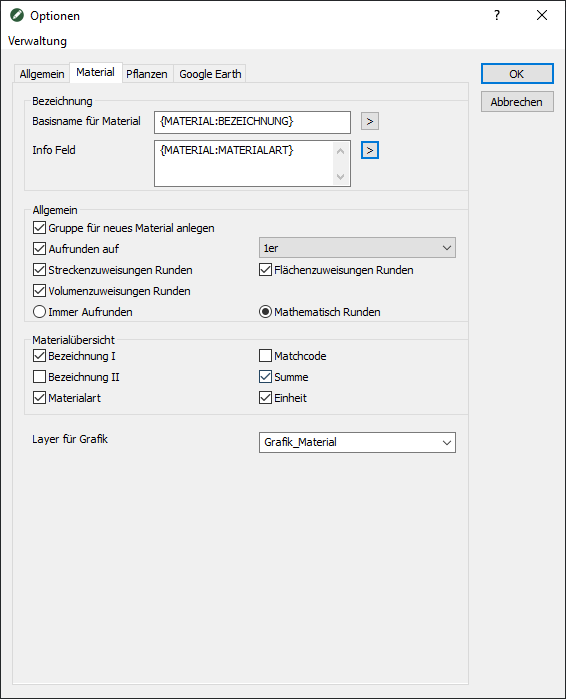
| designation | In the tab Material is the Base name for material changeable. Im Info field variables can be added, their values then in Info field on the tab Features be entered. The specifications apply to new materials that are inserted into the drawing. |
| General | Here, among other things, a rounding can be set for the determined sum of materials. This setting applies the next time the object manager is called, ie all materials entered so far are rounded. |
| Material overview | The options selected here are shown as information in the tabular view in the tab objects and in the tab Material shown. |
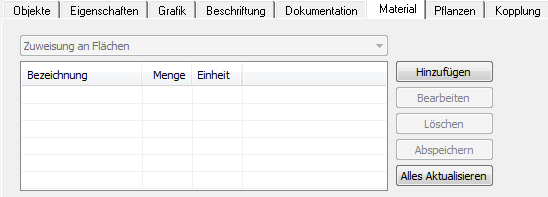
Furthermore, the Layer for graphics can be preset. This setting applies to new materials that are inserted into the drawing.
The settings for designation and Layer only have an effect on new materials that are inserted into the drawing. The settings from the area General and Material overview are available the next time the Object manager or with F5 is available for storage, management and analysis.
Plants tab
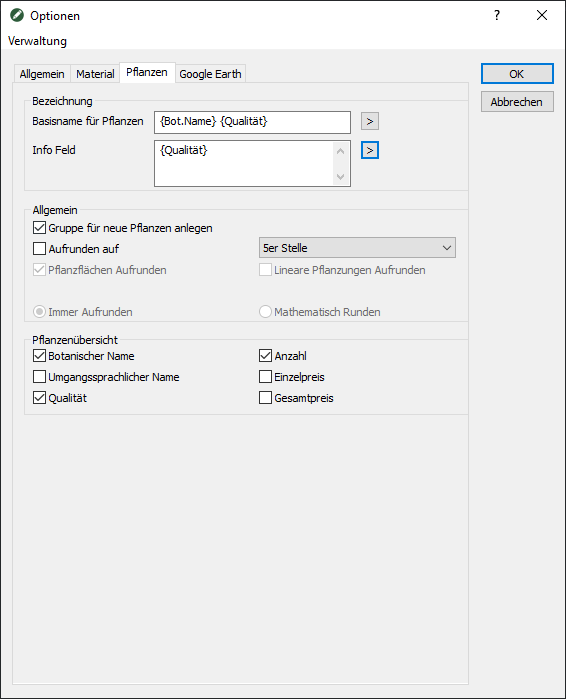
| designation | In the tab plants is the Base name for plants changeable. Im Info field variables can be added, their value then in Info field on the tab Features be entered. The default applies to new plants that are added to the drawing. |
| General | Among other things, a rounding can be set here for the calculated sum of the plants. This setting applies the next time the object manager is called. This means that all plants recorded so far are rounded. |
| Plant overview | The options selected here are shown as information in the tabular view of the tab objects as well as the tab plants shown. |
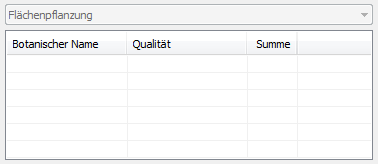
Furthermore, the Layer for graphics can be preset. This setting applies to new plants that are inserted into the drawing.
The settings for designation and Layer only have an effect on new plants that are inserted into the drawing. The settings from the area General and Plant overview are available the next time the Object manager or with F5 is available for storage, management and analysis.
Google Earth tab
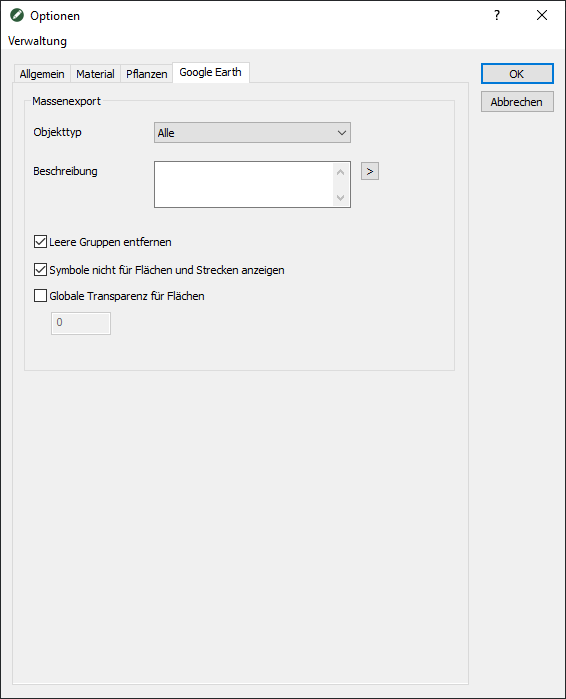
| Property Type | The labeling of the Google Earth objects can be for everyone Property Type individually or for [All] equally defined. |
| Description | in The Field Description Variables can be added, the values of which are then entered in the properties of the objects in Google Earth and, if necessary, separated according to object types. |
| Remove empty groups | Groups to which no object or no Google Earth graphic has been assigned are not exported to Google Earth. |
| Do not show symbols for areas and routes | Graphics of the object type Piece are not exported to Google Earth. This can occur, for example, if the graphics for piece, distance and area are assigned superordinately and are therefore inherited by all objects. For each created Google Earth graphic, an object is created in Google Earth. This can lead to objects being created multiple times in Google Earth. |
| Global transparency for areas | Becomes a value for the Global transparency for areas specified, the surface colors are displayed in Google Earth with the corresponding transparency. |


